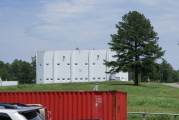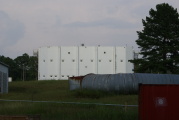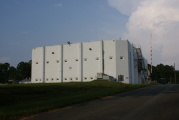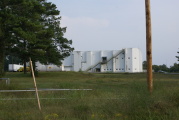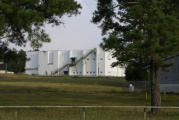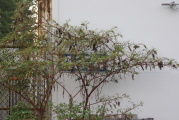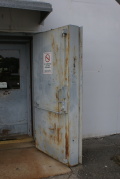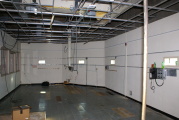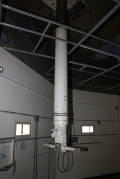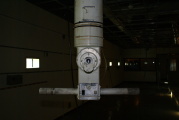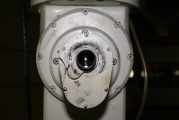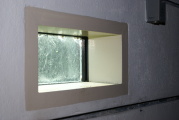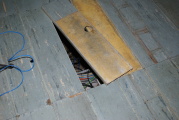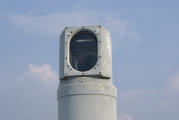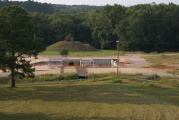Return to Marshall Space Flight Center
West Test Area Control Facility (Blockhouse)
Marshall Space Flight Center's West Test Area has historically hosted two test stands, the S-IC Test Stand and the F-1 Engine Test Stand. These two test stands shared a single blockhouse (aerial view). The blockhouse was originally known as the "Saturn Static Test Facility Control Center," then the "Control Center Building," and is currently simply the "Control Facility" or MSFC Building 4674. I mostly refer to it as the "blockhouse."
The Historic Assessment of Marshall Space Flight Center describes the blockhouse as such:
Building 4674 is the blockhouse for the West Test Area. The two-story, reinforced concrete structure is 128' by 107' in footprint. Building 4674 is about 44' high. A partial basement includes a main 450' cableway tunnel exiting its west facade and two cableway tunnels of smaller diameter exiting the north and south facades. (The Facilities Databook for the MSFC denotes the smaller tunnels as "future cable tunnels," but with respect to at least the north tunnel this appears to be an error. The north cable tunnel should be active and connecting to Building 4696, a test stand for the F-1 engine.) Both first and second floors of Building 4674 feature viewing ports across the width of the west facade. Exterior corners of the blockhouse are angled at the northwest and southwest, and include single viewing ports on the first and second stories. Viewing ports continue on the north facade, clustered near the northwest corner. These ports are configured as thee [sic] on the first floor and seven on the second story (facing Building 4696). On the south facade, each floor features two viewing ports, closely clustered at the southwest corner of the blockhouse. facade, each floor features two viewing ports, closely clustered at the southwest corner of the blockhouse. Massive vertical buttresses (exterior piers) additionally articulate the exterior of Building 4674. The blockhouse is the control facility for two major [Saturn test stands].Aetron, a division of Aerojet of Los Angeles, designed Building 4674 in 1961, simultaneously with its efforts for Building 4670 (the Saturn V static test stand). The blockhouse is the control facility for two major test stands constructed for the Saturn program, Buildings 4670 and 4696. Basement cableway tunnels suggest that NASA originally planned to erect three test stands, with the third positioned to the south of Building 4674, west of the intersection of Saturn and Lem Roads. Building 4674 housed instrumentation, control, and communications equipment, providing a safe area for engineers and test personnel during static firings on Buildings 4670 and 4696.
. . . Building 4674 is strongly associated with Saturn testing in the West Test Area; is paired with Building 4670 in particular; and, is an excellent example of major blockhouse design and engineering for the space program nationwide.
In the more modern era, the blockhouse was used as offices for MSFC engineers. On May 21, 2012, a minor fire on the second floor caused smoke damage to much of the second floor, and most of the engineers have subsequently been moved to offices in other buildings.
That being said, the second floor observation room still has its observation periscope and intercom station.
Return to Marshall Space Flight Center


